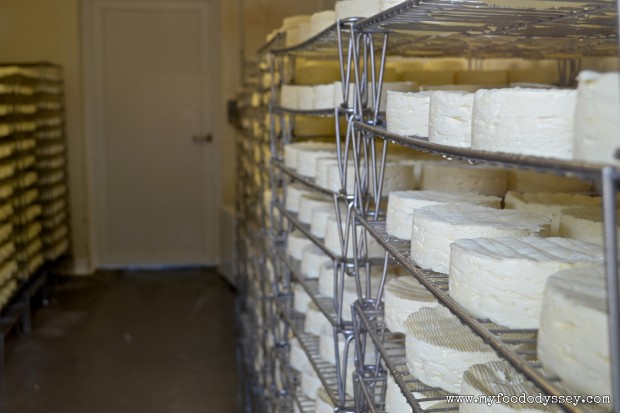Sweet cheeses – the Normandy quartet

Few places I’ve visited have struck me as more insignificant that the tiny village of Camembert in Normandy. Having travelled a considerable distance to visit the birthplace of the iconic cheese, I was incredibly underwhelmed. The village itself consists of a handful of houses, a church, a tacky cheese museum and an even tackier Tourist Office, which seems to concern itself primarily with selling cheese-related trinkets and tasting plates of Normandy cheeses, as well as presenting a small amount of information on how the various cheeses are produced.
As a small mercy, I was delighted to find that the information was presented in English as well as French so that I could understand the distinctions between the cheeses.

There are four notable Normandy cheeses – Neufchâtel, Livarot, Pont L’Évêque and of course the famous Camembert. All four cheeses are somewhat similar in that they are soft or semi-soft cow’s milk cheeses. The most immediately discernible difference is their shape – the Camembert & Livarot are always round, the Pont L’Évêque square or rectangular, while the Neufchâtel comes in a variety of shapes, but is most traditionally heart-shaped. The second obvious difference is that the Livarot and Pont L’Évêque are washed-rind cheeses, giving them a rind with a colour from golden yellow to dark orange, while the Camembert and Neufchâtel both have a slightly furry, white rind.
All four cheeses are protected by AOC (Appellation d’Origine Contrôlée) rules governing their provenance, ingredients and methods of production. Both the Camembert and the Livarot must be made with raw, unpasteurised milk. The milk for all four must come from specific regions, different for each cheese but all within the Normandy region. Unfortunately the AOC system doesn’t prevent the names being used elsewhere – versions of Camembert are produced worldwide (frequently, with pasteurised milk). However, only those produced in accordance with the rules can use the “AOC” label.
The strongest and most pungent of the four is the undoubtedly the Livarot, a result of the continuous washing (with both water and vegetable oil) during the long, 3-month maturation process. The result is a distinctly cow-like smell and a deeply flavourful cheese. This is not a cheese to accidentally leave in the car on a warm day! Fully ripe versions of the other three, which all take about 5 weeks to mature, also have great depth of flavour, but are more delicate than the Livarot.

A batch of Camembert maturing at François Durand’s farm in Camembert.

The angle is not me after sampling too much brandy! The racks are tilted.
I asked the rather sullen lady at the counter if there were any cheese producers in the village. She advised me that there were none in the village itself, but that one could be found about 3km outside the village. We headed down to the farm, where we watched a video on how the cheese is produced and had a look around the production rooms. We even got to meet the cheese maker, who reminded me enormously, both physically and in manner, of the scientist, David, played by Hank Azaria in “Friends”. We sampled the cheese and it was undoubtedly the best Camembert I’ve ever tasted, even if a little under-ripe. We bought a box and were noddingly advised to let it mature for at least another week before eating it. I wrapped the box in plastic so as not to be tempted and did as instructed. When we finally succumbed, it was oozingly soft in the middle and utterly delicious.

A balanced cheese plate would typically consist of 3-4 different but complementary cheeses, such as a soft, creamy Camembert, a washed-rind Livarot, a rich blue Roquefort and a hard Comté. Putting similar cheeses together on a cheese plate would be unusual. However, in the case of the Normandy cheeses, I think it is useful to taste all four cheeses – the two washed-rind and the two white-rind – side-by-side to appreciate their subtle differences. Choose ripe, AOC cheeses and allow them to sit at room temperature for at least two hours before serving. Serve with crispy, fresh baguette, crunchy sliced apple and a glass of chilled Normandy Pommeau or a mug of dry Normandy cider.
Note: It’s unlikely you’ll find AOC versions of these cheeses in a supermarket, but they should be available from a good cheesemonger or speciality food store.
Like what you see? Then please subscribe to My Food Odyssey. For updates on my daily life you can follow me on Facebook, Twitter and Pinterest.































This looks amazing… will have to check it out when we visit France again 🙂
LikeLiked by 1 person
Reblogged this on My Food Odyssey and commented:
In my final post from Normandy I visit the home of one of my very favourite foods – Camembert cheese. I was not disappointed!
LikeLike
What’s the difference between Camembert and Brie? I always get the two mixed up, Philistine as I am.
P.S. How many kilos have you put on so far June? 🙂
Great articles, looking forward to the next.
LikeLike
They’re pretty similar, Brian. For me the main differences are flavour and gooiness – the Camembert has a stronger taste and is softer in the middle when fully ripe. The Camembert is made with raw milk and the Brie with pasteurised. Apparently, the flavour difference is largely down to the fact that Camembert is made in small wheels and the Brie in large wheels, which reduces the rind-to-core ratio (or something like that!) And the bike is saving my ass! (Literally!)
LikeLike
I always understood that the process is subtly different with Brie having curds cut several times during the process but camembert curds being cut once of a size to fit the mould and that this leads to a more moussy texture in the Camembert.
LikeLiked by 1 person
The cutting of the curds might well be a factor, Osyth, but it’s not the only factor. Unfortunately I didn’t get to Brie to see their methodology. Looking online I can see recipes that have the curds for each being cut to the same size and just the once. Other sources have the curds cut to different sizes, but again just once. Those might not be the original, AOP methods, though. In fact, their unlikely to be. Both cheeses are now made outside the areas and indeed outside France and some variation will occur. The only consistency I can find is that Brie is a larger wheel. Even at that there are now “baby Brie” cheeses. Here in LT we have Camembert that is smaller than the correct size. So who knows!
LikeLike
You are making me hungry and there’s no Camembert in the house. 😦
LikeLike
Sorry John! You’ll just have to go and get some – have a nice cheese plate over the long weekend!
LikeLike